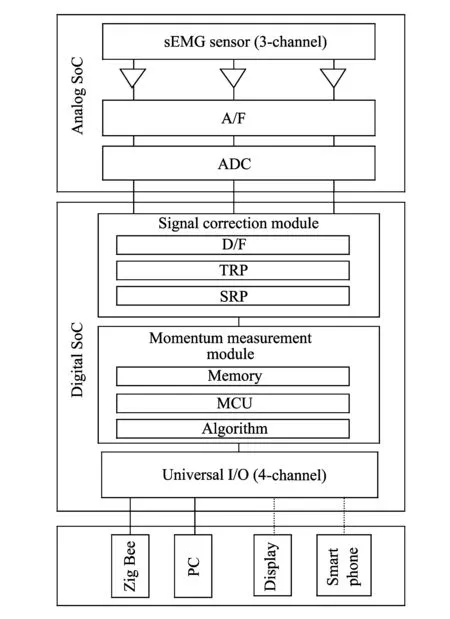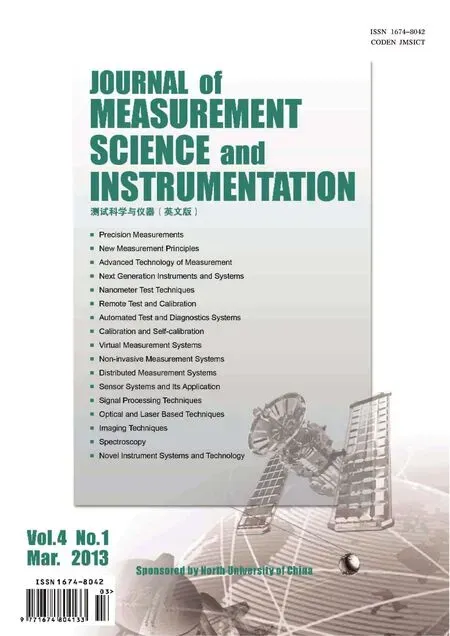Digital FIR filter design for bio-signal processing system
Woojin Nam, Guang Yang, Seongsoo Lee
(School of Electronic Engineering, Soongsil University, Seoul 156-743, Korea)
Digital FIR filter design for bio-signal processing system
Woojin Nam, Guang Yang, Seongsoo Lee
(School of Electronic Engineering, Soongsil University, Seoul 156-743, Korea)
Recently, real-time processing systems for bio-signal of the muscles generated by the movement of the user have been developed. Finite impulse response (FIR) filter for bio-signal processing in bio-signal process systems is composed of multiple multiplier and adder of high-area. This makes the chip area increase significantly. To solve this problem, a low-area digital FIR filter is proposed in this paper, which can reduce the chip area.
low area; digital finite impulse response (FIR) filter; bio-signal processing
0 Introduction
With the development of advanced medical technology, continuous development of new drugs is flooded with health-related knowledge, but the reality is still an uphill battle with a chronic illness. Spending of the cost of health care above economic growth rate, we cannot escape from the dilemma of the center of treatment according to the lack of information. In addition, the burden of medical cost is constantly increasing because of surging in demand for aged care services and increasing chronic disease due to low fertility and aging. And increasing loss of social and economic cost such as the increase of prevalence due to unhealthy lifestyle, huge medical expenses that are required to treat, and loss of productivity due to illness that is recognized to deal with by the social and national level beyond the personal interests. To escape from the proliferation of chronic illness due to aging and new disease outbreaks due to industrial upgrading, obesity and complications due to food and eating habits and a variety of diseases, scientific management movement has been steadily suggested. Sports activities that are playing 1 or 2 times per week regularly reduce the incidence of the disease and using of the frequency of health service and can obtain economic effects by increasing productivity. In the past, signal processing measured only the physical movement by the user's external environment. Recently, real-time processing systems for bio-signal of the muscles generated by the movement of the user have been developed. Biometric information can be represented as physiological signals and stress exponential by using bio-signal as well as health information. These bio-signal measurement devices feel inconvenient to move due to the size and wired interfaces. To solve this problem, research on a portable bio-signal measurement device is in progress[1-2].
In this paper, low area digital finite impulse response (FIR) filter for processing bio-signal information is proposed. Conventional FIR filter for processing bio-signal decides to create a significant chip area because of a number of multiplication and adder. To solve these problems, the low area digital FIR filter is proposed to minimize chip area.
1 Bio-signal processing system
The overall structure of bio-signal system is divided into analog system-on-chip (SoC) and digital SoC. Analog SoC is composed of sensor, analog filter and analog to digital converter (ADC). Digital SoC is composed of momentum measurement module and signal correction module. Bio-signal is converted to digital signal through ADC in analog SoC. Then it is sent to microprogrammed control unit (MCU) through FIR filter in digital SoC. This signal is processed in MCU using algorithms of bio-signal processing and momentum measurement. FIR filter contains FIR filter coefficient for noise reduction.
1.1 Analog SoC
Analog SoC is consists of three-channel sensor that measure electromyogram (EMG) signals, analog filter that can reduce noise and separate frequency band, ADC that converts analog signals into digital signals. Three-channel sensor measures EMG and analog filter classify frequency band for incoming signal from three-channel sensor. Signals of each frequency band are converted digital signals through ADC and transmitted to digital SoC.
1.2 Digital SoC
The transmitted signal from analog SoC goes through signal correction module, and then noise is removed and signal is compensated through TRP, SRP. Compensated signal measure the momentum in the momentum measurement module. Compensated signal measure the momentum in the momentum measurement module. Universal I/O can use the four channels.

Fig.1 Bio-signal processing system
In a system using sensors, sensor data reliability is required. Therefore, to prepare to break down sensor device, building block for the sensor array used as a plurality of the same type of sensor is common. The measured values at the same time in the sensor array through spatial relation processing use the same type of sensor data values spatially located in different locations, the status of each sensor signal value is determined normal or error. In situations where it is determined error, using around the same kind of sensor data to restore related sensor data value or sensor data value that is suspected, error is not sent to sensor signal processing block[3]. Process using temporal relation processing is used to compare tendency to decrease or increase for collected sensor signals of each sensor device and remove transient signals of very short time interval.
2 FIR filter
Digital filter is used FIR filter. FIR filter is called a finite impulse response system. FIR filter output has not been feedback. It calculates the output by the input. In addition, the stability is guaranteed and the phase is linear. This formula is a way by averaging the output. In other words, the output is to average error value.
y(n)=b0x(n)+b1(x-1)+
b2x(n-2)+…+bN-1x(n-N+1).
FIR filter structure consists of data shifter, multiplier that multiplies filter coefficients, adder that summarizes each value. Conventional 20-order filter is 21-tap filter that needs 21 multipliers that multiply input data by filter coefficients. Fig.2 is a general 20-order FIR filter structure. 21 multiplier and 20 adders are used to increase area, floating point multiplier composed of mantissa and exponent is for excellent performance but it is hard for area problem.

Fig.2 Conventional architecture
3 Proposed architecture
In this paper, to decrease area of adder, filter coefficients transform floating point into fixed point within the limit of minimum margin of error. In addition, Using the data output from the sensor that operates at low speed, we propose FIR filter that operates at high speed by using one multiplier and reusing adder while following input is coming. Fig.3 presents the proposed FIR filter structure. In Fig.3, we use shift register. First, input value and filter coefficients are matched, and then two values are multiplied and added. Finally, Data_out is obtained after 20 inputs come in. By using the same method, to decrease area of multiplier, multiplier is implemented by shifter and adder.

Fig.3 Proposed architecture
The input data can be forwarded to the a0 from a20. The data is shifted once per one clock. Therefore, to store in a0, it needs 20 clocks. At this point, multiplication coefficient for multiplication operation must also shift. Twenty-one inputs is multiplied with the corresponding coefficients. the results comes after sum of the value of 21.
4 Conclusion
In this paper, we propose low area FIR filters for bio-signal processing. Conventional FIR filter consists of 21 multipliers and 20 adders. So area of the filter is too large. The proposed FIR filter can be operated at the same operating frequency and can reduce power consumption because unnecessary operation is reduced about the multiplier and adder. In addition, the proposed filter significantly reduce the circuit area by reducing 20 multipliers and 19 adders. The number of 2-NAND of the conventional FIR filter is 21 492, but the number of 2-NAND of the proposed filter is 8 331. Therefore, the proposed filter can reduce 13 161 2-NANDs.

Table 1 2-NAND gate comparison
[1] Baek S J, Lee C H, Jung D H,et al. Implementation of sensing devices for ubiquitous health care system. In: Proceedings of the Korean Institute of Information Scientists and Engineers (KIISE) Conference, 2004, 31(1): 124.
[2] Lee H, Lee J, Jeong W, et al. Motion artifacts reduction from the PPG based on the improved PMAF for the U-healthcare system. In: Proceedings of the Institute of Electronics Engineers of Korea (IEEK) Conference, 2008, 45(5): 28-34.
[3] Park J S, Lee S S. Platform design for multiple sensor array signal verification. International Journal of Information and Communication Engineering, 2011, 15: 2480.
[4] Kim B, Kwon M J, Chun M G, et al. Bio-signal acquisition system using mobile device. FKIS, 2005, 15(1): 424.
[5] Kim D S, Eom S H, Jang M S, et al. The implementation of Bio-signal measurement for ubiquitous healthcare system. In: Proceedings of CICS Conference, 2009, 10: 95.
[6] OpenCore 8051. [2012-09-01]. http://www.opensocres.org/.
date: 2012-09-22
The MKE(the Ministry of Knowledge Economy), Korea, under the ITRC(Information Technology Research Center) support program supervised by the NIPA(National IT Industry Promotion Agency) (NIPA-2012-H0301-12-2006); the Seoul Metropolitan Government, under the Seoul R & BD Program supervised by Seoul Business Agency (ST110039)
Woojin Nam (nwj@ssu.ac.kr)
CLD number: Document code: A
1674-8042(2013)01-0094-03
10.3969/j.issn.1674-8042.2013.01.020
 Journal of Measurement Science and Instrumentation2013年1期
Journal of Measurement Science and Instrumentation2013年1期
- Journal of Measurement Science and Instrumentation的其它文章
- Image enhancement and post-processing for low resolution compressed video
- Acetonitrile (CH3CN) and methyl isocyanide(CH3NC) adsorption on Pt(111) surface: a DFT study
- Erosion thermocouple temperature acquisition system
- Dynamic calibration method of capacitive pressure measuring device
- Automatic measurement of air-pressure sensor based on two-pressure control instrument
- An experiment to estimate the revolution of DC motor
